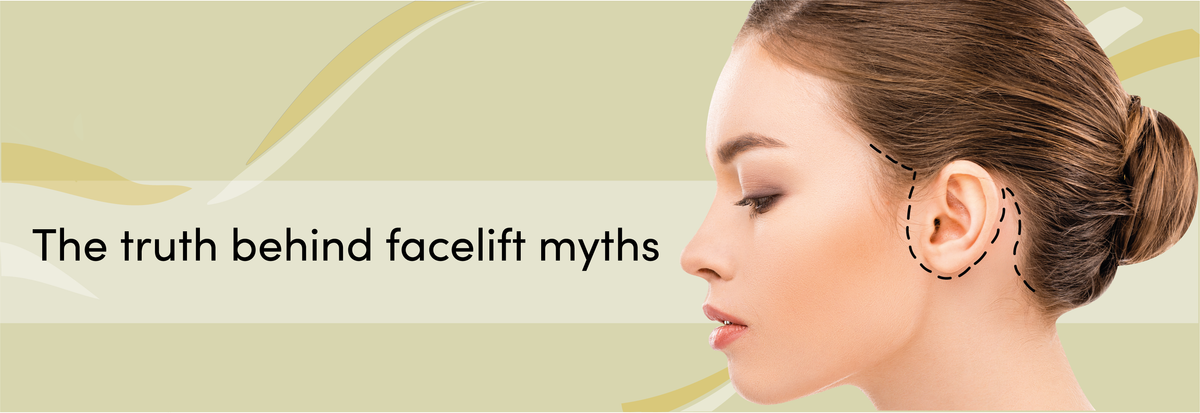Tutto quello che devi sapere sulla chirurgia del lifting del viso
Invecchiando, la nostra pelle perde naturalmente la sua elasticità e i segni dell'invecchiamento fanno il loro debutto. Alla fine, ciò si traduce in linee, rughe e pelle cadente, che lasciano molte persone a chiedersi come possono riavere la loro pelle giovane e dall'aspetto vibrante. Un lifting, noto anche come ritidectomia, è una procedura chirurgica comunemente utilizzata per rassodare i tessuti facciali e migliorare i segni visibili dell'invecchiamento su viso e collo. Nel 2020, più di 216.300 donne e 18.000 uomini negli Stati Uniti si sono sottoposti a un intervento di lifting, portando la ritidectomia tra le prime cinque procedure di chirurgia estetica. [1]
Cos'è l'intervento di lifting facciale?
Il lifting del viso è un intervento chirurgico complesso che mira a donare un aspetto giovanile alla pelle rassodando i tessuti del viso, rimuovendo il grasso in eccesso e distendendo le pieghe.
I lifting del viso vengono in genere eseguiti in anestesia generale, sebbene l'anestesia locale venga utilizzata anche per procedure meno invasive. A seconda del tipo di intervento, il medico esegue le incisioni iniziali per separare la pelle dai muscoli facciali profondi e dal grasso, rimuove la pelle in eccesso e riposiziona il tessuto sottostante. Una volta eseguite, le incisioni vengono chiuse con suture, che si dissolvono con il tempo o vengono rimosse dopo alcuni giorni. [2]

Perché sottoporsi a un intervento di lifting?
Età, danni del sole, fumo e stress alterano innegabilmente l'aspetto e la forma del nostro viso nel tempo. Per alcuni, vedere la propria pelle attraversare il naturale processo di invecchiamento provoca frustrazione, ansia e un calo di sicurezza. Sebbene sia impossibile tornare indietro nel tempo, gli interventi di chirurgia estetica restaurativa come il lifting possono migliorare il benessere psicologico e sociale dei pazienti, affrontando le loro aree di preoccupazione.
Ecco alcuni dei motivi più comuni per cui donne e uomini di tutte le età scelgono di sottoporsi a un intervento di lifting:
- Eliminare il doppio mento
- Sbarazzarsi delle guance cadenti
- Rassodare la pelle flaccida del viso
- Ridurre le rughe profonde
- Sollevare gli angoli della bocca
- Ridurre le pieghe tra le labbra e le guance
- Contrasta i segni dell'invecchiamento, tutto in uno.
- Ripristina un aspetto giovanile e una pelle dall'aspetto luminoso.
Quali sono i diversi tipi di intervento di lifting facciale?
Esistono diversi tipi di intervento di lifting. [3] Spetta al paziente e al suo chirurgo selezionare l'opzione giusta per le proprie esigenze e aspettative. Alcuni dei fattori solitamente considerati quando si decide sono lo stato di salute del paziente, l'età, le aree di interesse e il grado di cambiamento previsto.
Mini lifting
Come procedura meno invasiva, il Mini Facelift è adatto alle persone che soffrono di un leggero rilassamento cutaneo attorno al viso e al collo. In un Mini Facelift, il medico utilizza incisioni più piccole, in genere lungo l'attaccatura dei capelli, per sollevare e rassodare i tessuti sottostanti, rifinire la mascella e dare al paziente un aspetto ringiovanito.
Lifting di metà viso
Il Mid-Facelift è mirato alla parte centrale del viso, dalla parte superiore della bocca alla zona degli occhi. La procedura solleva anche le guance per creare linee di guance giovanili ed energiche. Per chi è? Chiunque cerchi un aspetto della pelle raffinato e sollevato sotto gli occhi e sopra la bocca che sembri naturale e nativo.
Lifting completo del viso
Un lifting completo, spesso definito lifting tradizionale, affronta i problemi legati all'invecchiamento per rinnovare l'aspetto dei pazienti in modo olistico. In un lifting completo, il chirurgo si concentra su varie aree, dal rilassamento cutaneo e dalle rughe al doppio mento e alle pieghe naso-labiali. La procedura prevede incisioni più lunghe e, come qualsiasi altro tipo di chirurgia estetica, richiede una vasta esperienza in anatomia facciale.
Sebbene quanto sopra serva da guida generale ai diversi tipi di lifting, è importante ricordare che il medico è la persona più indicata per consigliarti l'opzione più adatta alle tue esigenze e aspettative individuali.
La vita dopo un lifting
Lividi, gonfiore e dolore sono effetti collaterali attesi dopo un intervento di lifting. Il medico prescriverà antidolorifici per alleviare il dolore e il fastidio nei primi giorni.
Sebbene ogni persona sperimenterà una guarigione a un ritmo diverso, il gonfiore e i lividi in genere scompaiono dopo 10-14 giorni e i pazienti possono tornare alle loro normali attività entro 2-4 settimane. [3]
Cura di sé dopo un intervento di lifting
Per ottenere il massimo dal tuo recupero, è essenziale seguire le istruzioni del tuo medico e, allo stesso tempo, concederti il tempo e le cure di cui hai bisogno per guarire completamente. I seguenti suggerimenti ti aiuteranno ad accelerare il processo di guarigione e a prolungare i risultati del tuo lifting.
- Evitare il trucco
- Evitare attività e sport faticosi
- Proteggi il tuo viso dal sole
- Evitare pressioni e movimenti eccessivi
- Mangiare pasti sani e ricchi di nutrienti per accelerare il processo di guarigione.
- Evitare di bere alcolici e fumare
- Mantenetevi idratati bevendo almeno 2 litri di acqua
- Dormire a sufficienza
- Dormire con la testa sollevata
Dovrei indossare indumenti compressivi durante la convalescenza?
Gli indumenti compressivi sono essenziali per il tuo recupero. Gli indumenti compressivi forniscono supporto, stimolano la guarigione dei tessuti e riducono al minimo gonfiore e lividi durante il processo di guarigione. Poiché indosserai il tuo indumento compressivo quasi 24 ore al giorno, è essenziale che ti calzi bene e che ti senta a tuo agio e supportato.
Il lifting postoperatorio Calla con impacchi freddi può aiutarti a vivere una convalescenza senza stress, alleviando il disagio, fornendo supporto e prevenendo ematomi, gonfiori, lividi e infiammazioni. È dotato di una fascia per il collo e di sottili nastri elastici attorno alla parte posteriore della testa per mantenere la compressione nella posizione corretta, aiutando al contempo la pelle flaccida a ritrarsi e riattaccarsi.
Quando non è presente alcuna incisione dietro le orecchie o quando non è necessario il trattamento a freddo dietro le orecchie, la compressione per mento e guance Calla con impacchi freddi è un supporto compressivo eccezionalmente bello, leggero e confortevole.
La nostra tabella delle taglie ti aiuterà a trovare la taglia giusta in base alle tue misure. Tuttavia, se hai bisogno di qualche consiglio da un esperto, contattaci , e i nostri consulenti saranno più che lieti di aiutarti a scegliere la soluzione più adatta a te.
Porta via
I lifting sono un intervento chirurgico comune con in genere alti tassi di soddisfazione. Assicurati di consultare un chirurgo plastico certificato per discutere le tue aspettative e preoccupazioni e quindi decidere il tipo di intervento chirurgico più adatto a te. Sebbene questo articolo serva come guida generale al recupero, è importante riconoscere che il percorso di guarigione di ogni persona è diverso, a seconda del tipo di procedura, di eventuali problemi di salute e dell'aderenza ai protocolli post-operatori.
Elenco dei riferimenti
- Chirurgia plastica.org. 2022.
- Società americana di chirurghi plastici. 2022. Fasi della procedura di lifting del viso.
- Società americana di chirurghi plastici. 2022.
- Americanboardcosmeticsurgery.org. 2022.
- Medicalnewstoday.com. 2022. Lifting del viso: cosa aspettarsi e possibili complicazioni.
Lascia un commento
I commenti saranno approvati prima di essere condivisi.
Anche in Blog

Come mantenere i risultati dopo un'addominoplastica
Molti di noi sognano una vita più piatta, soprattutto dopo una gravidanza, una rapida perdita di peso o fluttuazioni di peso costanti. Tuttavia, per molte persone, è quasi impossibile ottenerla solo con esercizio fisico e dieta.
Un'addominoplastica fornisce un modo sicuro ed efficiente per affrontare questi problemi e ripristinare l'aspetto piatto e sodo della tua sezione centrale. Prendersi cura del proprio corpo e mantenere una dieta sana e un regime di esercizi assicura che i risultati dell'addominoplastica durino per tutta la vita.
Se stai pensando di sottoporti a un intervento di addominoplastica, continua a leggere per scoprire i nostri consigli su come mantenere risultati duraturi dopo l'intervento.






